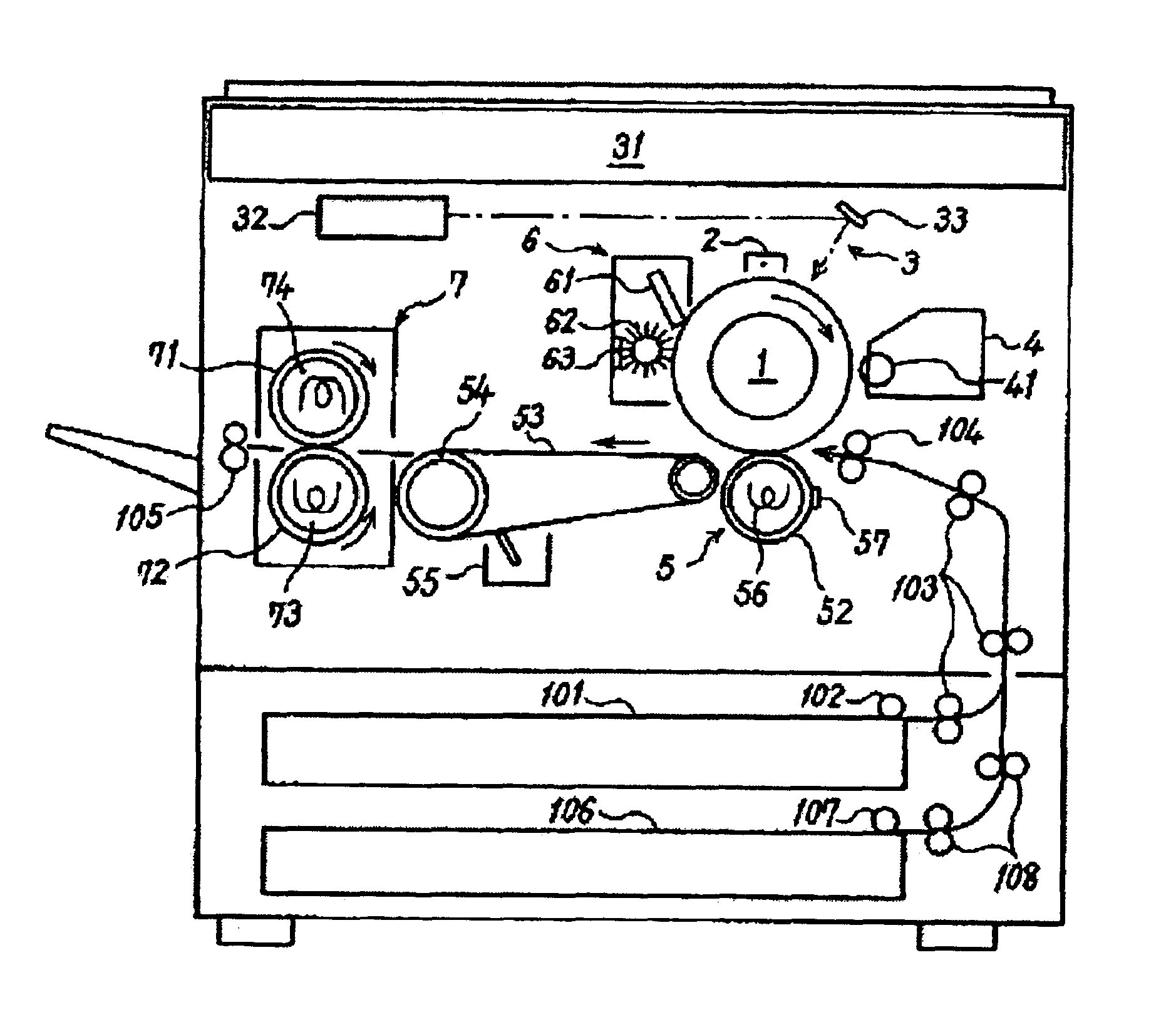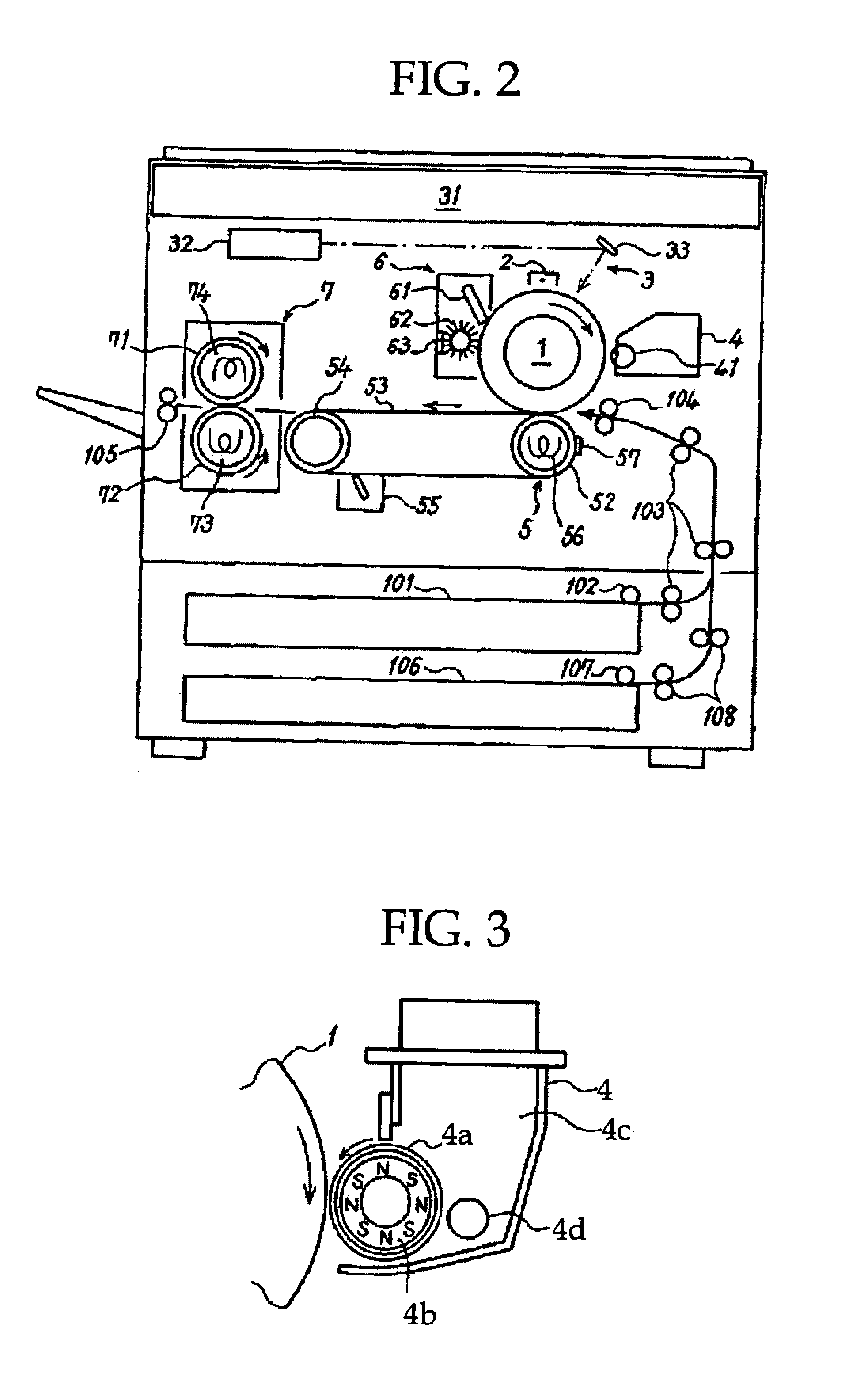Image-forming apparatus and image-forming method
a technology of image forming apparatus and image carrier, which is applied in the direction of electrographic process apparatus, instruments, optics, etc., can solve the problems of insufficient image quality, large image deterioration, and insufficient image quality, so as to reduce image deterioration due to heat propagation from the transfer means to the image carrier, reduce and avoid image deterioration due to transfer dust
- Summary
- Abstract
- Description
- Claims
- Application Information
AI Technical Summary
Benefits of technology
Problems solved by technology
Method used
Image
Examples
examples i-1 to i-5
[0110]The method of manufacturing the toner will now be described.
[0111]
[Toner 1](Toner ingredients)Polyester resin82parts by weight(weight average molecular weight: 208000, Tg: 57)Polyethylene wax5parts by weight(molecular weight 900)Carbon black (Mitsubishi Chemical Corporation,12parts by weightNo. 44)Charge controlling agent (Spiron Black TR-H:1part by weightHodogaya Chemical Co., Ltd.)
[0112]The above ingredients were kneaded at 100° C. using a two-axis extruder, crushed in an air current mill, graded to a weight average particle diameter of 9.5 μm (weight average particle diameter / number average particle diameter=1.45), and mixed with 0.15% by weight of silica (R-972, Japan Aerogel) a Henschel mixer to obtain a toner.
[0113]The softening temperature of this toner was 98° C., the volume resistivity was 9.5×108 Ω·cm, the average sphericity was 0.88, Tg was 58° C., the temperature at which the melt viscosity was 1000 PaS was 115° C., and the apparent density was 0.28 g / cc. A carrier...
example ii
[0156]Next, examples of using a low resistance toner will be described.
[0157]The Inventors manufactured 9 types of toner referred to as Developer A-Developer I, and output images using these toners. Specifically, the following 9 toner compositions, referred to as Composition A-Composition I, were prepared.
[0158]
[Composition A]Polyester resin:89 parts by weight(weight-average molecularweight: 325000, glass transitiontemperature Tg: 67.5° C.)Polyethylene wax (molecular weight 900): 5 parts by weightMagnetite particulates:50 parts by weightCarbon black: 3 parts by weight(Ketchen Black EC, Ketchen Black International)Charge controlling agent 1 part by weight(Spiron Black TR-H, HODOGAYACHEMICAL CO., LTD., hereafter idem):[Composition B]Identical to Composition A, except that carbon blackwas changed to 5 parts by weight.[Composition C]Polyester resin:89 parts by weight(weight-average molecular weight: 325000,glass transition temperatureTg: 67.5° C.)Polypropyrene wax: 3 parts by weight(mol...
example iii
[0180]Next, examples of an image-forming apparatus and an image forming method according to the present invention, wherein a pressure of 10-100N / cm2 is applied between the transfer roller and photoconductor, will be described.
[0181]As the developer used in Example III, 10 types of developers A-J were prepared.
[0182]
Developer A(Toner ingredients)Polyester resin82 parts by weight(weight average molecular weight: 52000,Tg: 54° C.)Polyethylene wax 5 parts by weight(molecular weight 900)Carbon black (Mitsubishi Chemical12 parts by weightCorporation, No. 44)Charge controlling agent (Spiron 1 part by weightBlack TR-H: Hodogaya Chemical Co.,Ltd.)
[0183]The above ingredients were kneaded at 80° C. using a two-axis extruder, crushed in an air current mill, graded to a weight average particle diameter of 9.5 μm (weight average particle diameter / number average particle diameter=1.45), and mixed with 0.25% by weight of silica (R-972, Japan Aerogel) using a Henschel mixer to obtain the following t...
PUM
 Login to View More
Login to View More Abstract
Description
Claims
Application Information
 Login to View More
Login to View More - R&D
- Intellectual Property
- Life Sciences
- Materials
- Tech Scout
- Unparalleled Data Quality
- Higher Quality Content
- 60% Fewer Hallucinations
Browse by: Latest US Patents, China's latest patents, Technical Efficacy Thesaurus, Application Domain, Technology Topic, Popular Technical Reports.
© 2025 PatSnap. All rights reserved.Legal|Privacy policy|Modern Slavery Act Transparency Statement|Sitemap|About US| Contact US: help@patsnap.com



